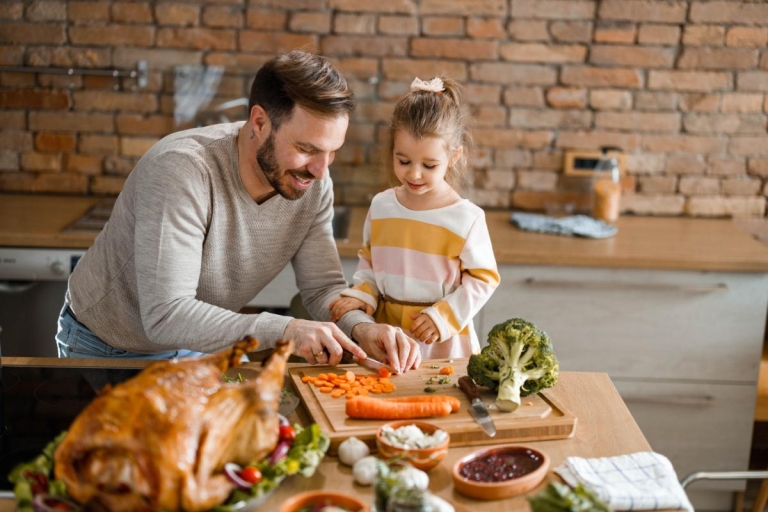11/22/21 blog post
A hazard-free Thanksgiving feast

Thanksgiving is coming up and there are some special precautions to take while cooking such a large meal. Dayton Children’s food equity manager Emily Callen says “We know eating and cooking together is great for family bonding, but we want to make sure all members of the family have a safe and fun time while helping out in the kitchen. There are so many great recipes to be made, especially around the holidays.”
Use these tips when preparing the Thanksgiving feast for family and friends.
- Turkey safety:
- Buy carefully and keep it in the fridge if bought 1-2 days before you cook it. Store it in the freezer if you’ve bought it earlier.
- Defrost properly:
- Thaw in the refrigerator (one day to thaw for every 4-5 lbs). Submerge the turkey wrapped in leak-proof packaging in cold water (30 minutes for every 1 lb).
- Microwave in a microwave-safe pan, removing any packaging and following the manufacturer’s instructions.
- Cook immediately after thawing at 165 degrees F at least.
- Stay home when cooking your turkey and check on it frequently. Turkey fryers can easily overheat and start a fire.
- Use a thermometer on the innermost portion of the thigh and wing, as well as the thickest section of the breast, to ensure that the turkey is well cooked.
- Don’t carve instantly; instead, give the juices time (about 20 min.) to settle.
- Keep the floor clear so you don’t trip over shoes, toys, or bags.
- Stock up on potholders! Lots of hot pots and pans are being used in a short period of time. Do not use a towel to grab hot items, the heat will quickly move through the towel and burn your hand.
- Thanksgiving is a social supper. Choking is a very risky possibility. Immediately perform CPR or call 911 if the person can’t cough, breathe, or speak.
- Store leftovers properly to eliminate food poisoning.
- Refrigerate leftovers promptly, no more than 2 hours after food has been served.
- Leftovers are most harmlessly eaten within 3 days or should otherwise be transferred to the freezer.
What happens if an injury occurs in the kitchen?
Cooking can lead to injuries minor to severe. Here are the most common injuries Dayton Children’s emergency department sees related to cooking:
- Cuts (minor wounds): If a cut occurs, make sure to use a clean paper towel or gauze to apply pressure to the wound until the bleeding stops. Wash the wound with warm soapy water. Dry the wound, apply an antibacterial cream (like Neosporin) and bandage.
- Burns: If you get a minor burn, run the affected area under cold water until you feel relief. Then dry the area, apply a burn ointment, and bandage. Kids’ skin is thinner than adults, burns can be severe and may need specialized treatment. If the burn is severe, seek medical attention.
Learn more about safe cooking practices with kids here: Kids Cook | Dayton Children's (childrensdayton.org)

